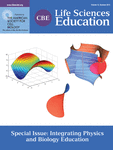Editorial Preface
What are effective ways to prepare undergraduates and K–12 students for the interdisciplinary nature of modern biology? How should we foster teaching across disciplinary and departmental boundaries? These important questions are addressed here in essays from three science educators who represent different perspectives and professional experiences. Michael Marder, physics professor at University of Texas at Austin and codirector of the UTeach teacher education program, discusses his concerns about the inclination of educators and policy makers to confound very different science disciplinary challenges under the common heading of “STEM.” David Van Wylen, biology professor at St. Olaf College, and colleagues from other science and math departments there, describe how their small liberal arts college has made significant progress in moving science education to an interesting interdisciplinary model. Barbara Nagle, K–12 curriculum developer at the Lawrence Hall of Science at the University of California, Berkeley, writes about the difficulties of preparing middle and high school students for the interdisciplinary nature of the course work they will encounter in college, and the related implications of the Next Generation Science Standards. In line with this special issue of CBE—Life Sciences Education, all three essays make interesting connections between physics and biology education. Readers are encouraged to compare the authors’ perspectives and share their thoughts and reactions using the Submit a Reader Comment tab in the sidebar to the right of the online essays.



